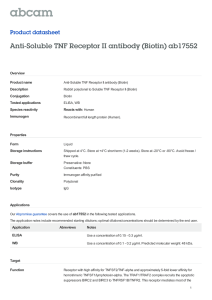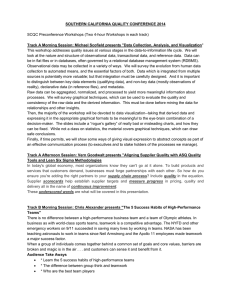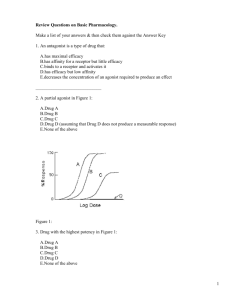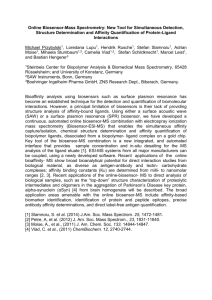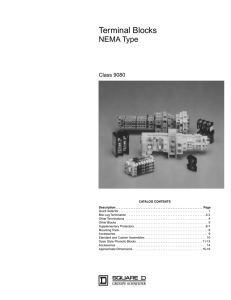BIOMIRROR p of Oestrogen Receptor Modulating Molecules
advertisement
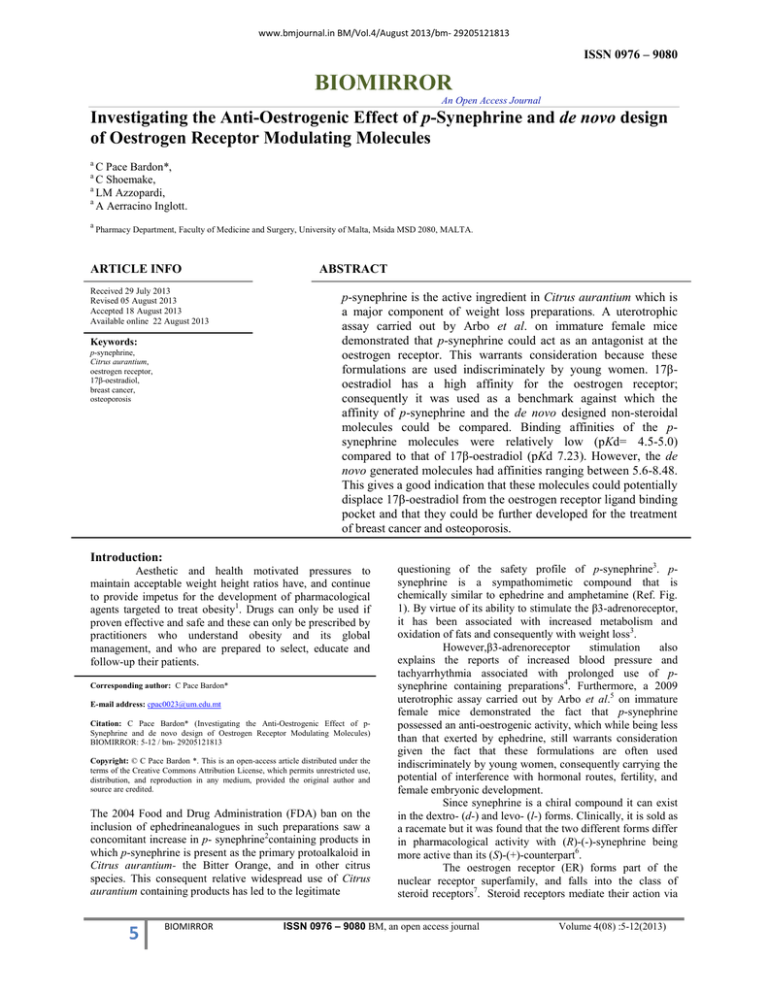
www.bmjournal.in BM/Vol.4/August 2013/bm- 29205121813 ISSN 0976 – 9080 BIOMIRROR An Open Access Journal Investigating the Anti-Oestrogenic Effect of p-Synephrine and de novo design of Oestrogen Receptor Modulating Molecules a C Pace Bardon*, C Shoemake, a LM Azzopardi, a A Aerracino Inglott. a a Pharmacy Department, Faculty of Medicine and Surgery, University of Malta, Msida MSD 2080, MALTA. ARTICLE INFO Received 29 July 2013 Revised 05 August 2013 Accepted 18 August 2013 Available online 22 August 2013 Keywords: p-synephrine, Citrus aurantium, oestrogen receptor, 17β-oestradiol, breast cancer, osteoporosis ABSTRACT p-synephrine is the active ingredient in Citrus aurantium which is a major component of weight loss preparations. A uterotrophic assay carried out by Arbo et al. on immature female mice demonstrated that p-synephrine could act as an antagonist at the oestrogen receptor. This warrants consideration because these formulations are used indiscriminately by young women. 17βoestradiol has a high affinity for the oestrogen receptor; consequently it was used as a benchmark against which the affinity of p-synephrine and the de novo designed non-steroidal molecules could be compared. Binding affinities of the psynephrine molecules were relatively low (pKd= 4.5-5.0) compared to that of 17β-oestradiol (pKd 7.23). However, the de novo generated molecules had affinities ranging between 5.6-8.48. This gives a good indication that these molecules could potentially displace 17β-oestradiol from the oestrogen receptor ligand binding pocket and that they could be further developed for the treatment of breast cancer and osteoporosis. Introduction: Aesthetic and health motivated pressures to maintain acceptable weight height ratios have, and continue to provide impetus for the development of pharmacological agents targeted to treat obesity1. Drugs can only be used if proven effective and safe and these can only be prescribed by practitioners who understand obesity and its global management, and who are prepared to select, educate and follow-up their patients. Corresponding author: C Pace Bardon* E-mail address: cpac0023@um.edu.mt Citation: C Pace Bardon* (Investigating the Anti-Oestrogenic Effect of pSynephrine and de novo design of Oestrogen Receptor Modulating Molecules) BIOMIRROR: 5-12 / bm- 29205121813 Copyright: © C Pace Bardon *. This is an open-access article distributed under the terms of the Creative Commons Attribution License, which permits unrestricted use, distribution, and reproduction in any medium, provided the original author and source are credited. The 2004 Food and Drug Administration (FDA) ban on the inclusion of ephedrineanalogues in such preparations saw a concomitant increase in p- synephrine2containing products in which p-synephrine is present as the primary protoalkaloid in Citrus aurantium- the Bitter Orange, and in other citrus species. This consequent relative widespread use of Citrus aurantium containing products has led to the legitimate 5 BIOMIRROR questioning of the safety profile of p-synephrine3. psynephrine is a sympathomimetic compound that is chemically similar to ephedrine and amphetamine (Ref. Fig. 1). By virtue of its ability to stimulate the β3-adrenoreceptor, it has been associated with increased metabolism and oxidation of fats and consequently with weight loss3. However,β3-adrenoreceptor stimulation also explains the reports of increased blood pressure and tachyarrhythmia associated with prolonged use of psynephrine containing preparations4. Furthermore, a 2009 uterotrophic assay carried out by Arbo et al.5 on immature female mice demonstrated the fact that p-synephrine possessed an anti-oestrogenic activity, which while being less than that exerted by ephedrine, still warrants consideration given the fact that these formulations are often used indiscriminately by young women, consequently carrying the potential of interference with hormonal routes, fertility, and female embryonic development. Since synephrine is a chiral compound it can exist in the dextro- (d-) and levo- (l-) forms. Clinically, it is sold as a racemate but it was found that the two different forms differ in pharmacological activity with (R)-(-)-synephrine being more active than its (S)-(+)-counterpart6. The oestrogen receptor (ER) forms part of the nuclear receptor superfamily, and falls into the class of steroid receptors7. Steroid receptors mediate their action via ISSN 0976 – 9080 BM, an open access journal Volume 4(08) :5-12(2013) BIOMIRROR steroid hormones, such as 17β-oestradiol in the case of the ER. It is the predominant steroid hormone responsible for secondary sexual characteristics in females; thus it has a wide spectrum of functions, influencing most of the major organ systems in the body8. Figure 1: 2D structures of p-synephrine, Ephedrine and Amphetamine. p-Synephrine Ephedrine Material and Methods: Crystallographic data was obtained from the Protein Data Bank with Brzozowski et al.’s deposition 1ERE11 describing the human ER ligand binding domain crystallised as a hexamere complexed with 17β-oestradiol resolved to 3.1Å being used as a template (Ref. Fig. 2(a)). All molecular modelling was performed using Sybyl-X1.112. In silico estimations of Ligand Binding Affinity (LBA) were performed using XSCOREv1.313, and de novo molecular design was carried out using LigBuilderv1.214. The 3D coordinates of 1ERE were read into SybylX1.112ensuring preservation of the bound coordinates of the complex. Molecular simplification of ER through removal of unnecessary chains and water molecules was done in order to reduce the computer intensiveness in subsequent calculations (Ref. Fig. 2(b)-(d)). Computational extraction of 17β-oestradiol from its cognate LBP in Sybyl-X1.112 allowed preservation of its bound co-ordinates. The separate files were exported into XSCOREv1.313 in order to estimate a predicted in silico affinity of the ligand for its endogenous receptor. This figure was established as a benchmark against which the affinity of p-synephrine and the de novo designed molecules could be compared. Figure 2(a): 1ERE hexamere where the different colours represent the different chains generated using VMD15 Amphetamine The discovery of the ER and the first anti-oestrogen opened a door to innovation in the field of therapy for breast cancer and osteoporosis9. Tamoxifen and Raloxifene are known as Selective Oestrogen Receptor Modulators (SERMs) and act as anti-oestrogens to reduce the incidence of breast cancer in pre- and postmenopausal women in the case of tamoxifen, and toreduce the risk of osteoporosis high in risk postmenopausal women in the case of raloxifene10. This in silico study seeks primarily to validate computationally Arbo et al’s assertion of affinity of psynephrine for the Oestrogen Receptor Ligand Binding Pocket (ER_LBP). Based on these results, this study also proposes the p-synephrine scaffold as a novel non-steroidal pharmacophore which could be utilised in the context of a de novo drug design study to propose lead molecules with demonstrable high affinity for the ER, and with the concomitant potential for ER antagonism and acceptable bioavailability suitable for the treatment of breast cancer and osteoporosis. 6 BIOMIRROR Figure 2(b): Simplified 1ERE depicting 17β-oestradiol bound to the ER generated using VMD15 ISSN 0976 – 9080 BM, an open access journal Volume 4(08) :5-12(2013) BIOMIRROR Figure 2(c): ER void of ligand and water molecules generated using VMD15 Figure 3(a): 3D structure of the p-(R)-synephrine isomer generated using VMD15 Figure 2(d): The extracted ligand, 17β-oestradiol generated using VMD15 Figure 3(b): 3D structure of the p-(S)-synephrine isomer generated using VMD15 The 3Dstructures of the (R)- and (S)- isomers of psynephrine were generated using Sybyl-X1.112 (Ref. Fig. 3). The bioactive conformation of 17β-oestradiol was used as a template in a process that allowed the docked p-synephrine structures to assume numerous high affinity conformations within the ER_LBP (Ref. Fig. 4). These p-synephrine conformers were consequently identified, saved, and the Ligand Binding Energy (kcalmol-1) was calculated in SybylX1.112 for each conformer. Each conformation was subsequently individually exported to XSCOREv1.213and guided into the ER_LBP so that their affinity for the ER could be calculated and compared to that of 17β-oestradiol. 7 BIOMIRROR ISSN 0976 – 9080 BM, an open access journal Volume 4(08) :5-12(2013) BIOMIRROR Figure 4: The top 21 binding p-(R)-Synephrine (top) and p-(S)-Synephrine (bottom) conformers generated using VMD15 Figure 5(b):Seed 2 Figure 5(c): Seed 3 Figure 5(d): Seed 4 In the next part of the study, the p-synephrine conformer exhibiting a high computationally calculated affinity (pKd)and low binding energy (kcalmol-1) combinationwas identified as the pharmacophoric scaffold of choice for the de novo design of novel non-steroidal structures with the ability to occupy the 3D volume of the ER_LBP efficiently and with high affinity. To this end, the bound conformation of 17βoestradiol was once again invoked and used as a probe in order to establish the 3D volume of the ER_LBP together with the nature of the amino acid side chains delineating its perimeter. The selectedp-synephrine conformer was subjected to successive editing such that seed molecules capable of sustaining growth at pre-designated junctures (labelled H.spc) were created (Ref. Fig. 5) in an effort to be able to better identify which structural changes would have the greatest impact on LBA. Figure 5(a): Seed 1 8 BIOMIRROR ISSN 0976 – 9080 BM, an open access journal Figure 5(e): Seed 5 Figure 5(f): Seed 6 Volume 4(08) :5-12(2013) BIOMIRROR The seed structures were then introduced into the ER_LBP in an orientation identical to that of the selected psynephrine conformer. The growth of novel structures was then carried out using the GROW module of LigBuilderv1.214 according to a designed protocol that ensured chemical and synthetic feasibility. Furthermore, stringent limitations were placed on the nature of the molecular structures that were allowed to develop within the ER_LBP. Through the restriction of molecular weight, logP, and the amount of hydrogen bond donors and acceptors, it was ensured that all the obtained structures would lie well within Lipinski et al’s recommendations for ensuring bioavailability and that successive rounds of optimisation would not result in Lipinski Rule violators. Results: The in silico predicted LBA of 17β-oestradiol for the ER (PDB 1ERE) was 7.23, compared to those of the (R)and (S)-p-synephrine conformers which ranged from pKd 4.5 to 5.0 where higher values indicate greater LBA. The binding energies (kcalmol-1) were also quantified in SybylX1.1 for each conformer (Ref. Fig. 6). The implication of these results is that p-synephrine should only have a marginal affinity for the ER and that it would be incapable of displacing 17β-oestradiol from its cognate LBP in a competitive scenario. T he 3D image of the mapped ER_LBP and proposed pharmacophore based on the bound coordinates of 17βoestradiol are shown in figure 7. p-(R)-synephrine conformer 10 as shown in Figure 6(a) was chosen as the best binding conformer as it has a high binding affinity and low binding energy, and consequently this structure was used as a scaffold for further studies. Application of the de novo design process on the prepared seed structures according to the GROW module resulted in molecules with a significant increase in affinity where estimated binding affinities ranging from pKd 6.5 to 8.48. Five of the best binding molecules were selected as potential non-steroidal lead structures based on molecular weight, log P and LBA (Table1). Figure 6(a): Graph of Predicted LBA (pKd)/Binding Energy (kcalmol-1) for the 21 structural conformations of p-(R)-synephrine for the ER 9 BIOMIRROR ISSN 0976 – 9080 BM, an open access journal Volume 4(08) :5-12(2013) BIOMIRROR Figure 6(b): Graph of Predicted LBA (pKd)/Binding Energy (kcalmol-1) for the 21 structural conformations of p-(S)synephrine for the ER Figure 7(a): 3D map of the ER_LBP as delineated in the crystallographic deposition 1ERE generated using VMD15, where hydrogen bond donor grids can be seen in blue, hydrogen bond acceptor grids are shown in red, while hydrophobic grids are shown in cyan 10 BIOMIRROR Figure 7(b): Proposed pharmacophoric structure of potential high affinity ligands for the ER_LBPbased on the interactions forged between the bioactive conformation of 17β-oestradiol and the ER_LBP as delineated in PBD crystallographic deposition 1ERE. Graphics were generated using VMD15, and hydrogen bond donors can be seen in blue, hydrogen bond acceptors are shown in red, while hydrophobic regions are shown in cyan ISSN 0976 – 9080 BM, an open access journal Volume 4(08) :5-12(2013) BIOMIRROR Table 1. Five ligands with a high LBA for the ER_LBP shown below. Structural images were generated using MolSoftICM. Seed Mol. Family No Chemical Mol. Wt LogP pKd 3D structure No. No. 2 1 <1> C19H21O2 281 3.96 8.25 3 50 <3> C17H25O3 277 3.89 7.45 4 1 <1> C18H25NO2 287 3.95 8.40 5 35 <2> C17H2503 277 3.98 8.45 11 Formula BIOMIRROR ISSN 0976 – 9080 BM, an open access journal Volume 4(08) :5-12(2013) BIOMIRROR 6 12 <2> C17H2203 274 3.73 Discussion: Structural analysis and comparison of de novo designed ligands allowed the establishment of correlations between structure and affinity as follows; LBA increased as the degree of saturation decreased. 5) LBA was higher for those ligands which were structurally compact as opposed to the more structurally open ligands which exhibited a lower binding affinity. 6) LBA was higher for those ligands which were rich in aromatic rings, when compared to their straight chain counter parts. 7) Ligands containing a terminal hydrogen bond accepting ammonium group have a higher affinity than their nonterminal ammonium group counterparts. 8) 9) Ligands containing a terminal hydroxyl group exhibit an affinity that is higher than similar ligands in which this hydroxyl group is replaced by a carbonyl group. The study is valuable for a number of reasons. It is indicative of the fact that p-synephrine is not likely to complete successfully with 17-βoestradiol for the ER_LBP. Thus, potentially there should be no concern for the inclusion ofp-synephrine in dietary products due toin silico estimations of low affinity for the ER. It is also important in that it has shown that the synephrine scaffold is of utility in the design of molecules capable of interacting successfully with the ER_LBP. The fact that a number of the de novo designed ligands have an affinity greater than that of 17-β oestradiol augurs well for the competitive antagonism of this latter from the ER_LBP. This may be useful in the context of the clinical requirement for partial or total antagonism of the ER for the treatment of breast cancer and osteoporosis. References: 1) 2) 3) 4) 10) 11) 12) 13) 14) 15) 8.43 Current Status of Clinical and Basic Research.Exp. Biol. Med229:698-704. Arbo M, Franco M, Larentis E, Garcia S.C, Sebben V.C, Leal M.B, et al (2009) Screening for in vivo (anti)estrogenic activity of ephedrine and p-synephrine and their natural sources Ephedra sinica Stapf. (Ephedraceae) and Citrus aurantium L. (Rutaceae) in rats. Archives of Toxicology83(1):95-99. Pellati F, Benvenuti S, Melegari M (2005) Enantioselective LC analysis of synephrine in natural products on a protein-based chrial stationary phase. Journal of Pharmaceutical and Biomedical Analysis37:839-849. Thompson J (2006) Molecular Mechanisms of Androgen Receptor Interactions [Dissertation]. Finland: University of Helsinki. El Safoury O, Rashid L, Ibrahim M (2010) A study of androgen and estrogen receptors α, β in skin tags. Indian Journal of Dermatology55(1):20-24. Pate R, Jordan V (2009) Chemoprevention of Breast Cancer with Selective Estrogen Receptor Modulators. Current Medical Literature: Breast Cancer21(3):82-88. Jordan V.C, Gapstur S, Morrow M (2001) Selective Estrogen Receptor Modulation and Reduction in Risk of Breast Cancer, Osteoprosis, and Coronary Heart Disease. Journal of the National Cancer Institute 93(19):1449-1457. Brzozowski A, Pike A, Dauter Z, Hubbard R.E, Bonn T, Engstrom O et al (1997) Molecular basis of agonism and antagonism in the oestrogen receptor. Nature389(6652):753. SYBYL®-X [computer program].Version 1.1. St. Louis (MO): Tripos International; 1996. Wang R, Liu L, Lai L, Tang Y (1998) SCORE: a new empirical method for estimating the binding affinity of a protein-ligand complex. J Mol Model4(12):379-394. Wang R, Gao Y, Lai L (2000) LigBuilder: a multi-purpose program for structure-based drug design. J Mol Model 6:498516. Humphrey WE, Dalke A, Schulten K (1996)VMD- visual molecular dynamics. J Mol Graphics 14(1):33-38. Carek P, Dickerson L (1999) Current Concepts in the Pharmacological Management of Obesity. Drugs57(6):883-904. FDA (U.S. Food and Drug Administration). Sales of Supplement Containing Ephedrine Alkaloids (Ephedra) Prohibited, Febuary 6, 2004. 69 Fed. Reg. 6788. Blumenthal M (2004) Bitter Orange Peel and Synephrine: Part 1. WholeFoods. Austin: American Botanical Council. Fugh-Berman A, Myers A (2004)Citrus aurantium, an Ingredient of Dietary Supplements Marketed for Weight Loss: 12 BIOMIRROR ISSN 0976 – 9080 BM, an open access journal Volume 4(08) :5-12(2013)


